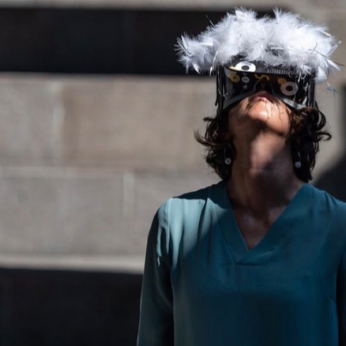SWAN – VR moving bodies (2021)
SWAN – VR Moving Bodies is a journey dedicated to 5 spectators at a time, guided through an experiential discovery of a virtual space blending irony, fragility, and grace. It’s a poetic act of irreverent and liberating transformation.
The project is inspired by “The Dying Swan,” the famous choreography by Michael Fokine and performed by Anna Pavlova in 1905-07, set to music by Saint-Saëns.
In her interpretation, Anna Pavlova infused movements into the choreography that expressed her feelings, performing a revolutionary act for dance at that time.
How can we keep alive the revolutionary act that was Pavlova’s Swan?
How does your body experience an intimate action immersed in Virtual Reality?
How do you choose to perform an action? A movement?
How can we transform ourselves into swans?
What constitutes a revolutionary movement?
SWAN – VR Moving Bodies is an intimate and light experience that uses virtual reality as a tool, not an end in itself.
It emerges from the intersection of the poetic research characterizing the two choreographers:
Silvia Gribaudi, a performer and dance maker who has been exploring dance, comedy, and audience interaction since 2008.
Margherita Landi, a choreographer, dancer, and anthropologist who has been researching body and new technologies since 2014.
A project by Silvia Gribaudi and Margherita Landi
VR video curated by Margherita Landi
Performer: Silvia Gribaudi
Production GOLD, Bolzano Danza / Fondazione Haydn e Zebra Associazione Culturale. L’’esperienza è stata creata grazie a “SWANS NEVER DIE “ progetto Biennale ideato da Lavanderia a Vapore/Piemonte dal Vivo, Operaestate Festival Veneto e Centro per la Scena Contemporana CSC,Bassano del Grappa, Triennale Milano, Teatro Brescia, Torinodanza Festival Bolzano danza; “Memory in Motion. Re- Membering Dance History (Mnemedance)” – Università Ca’Foscari Venezia; Ecole Universitaire de Recherche CREATES e Centre Transdisciplinaired’Epistémologie de la Littérature et des Arts Vivants, Université Côte d’Azur.
photo credit: Andrea Macchia

SWAN – VR moving bodies (2021)
SWAN – VR Moving Bodies is a journey dedicated to 5 spectators at a time, guided through an experiential discovery of a virtual space blending irony, fragility, and grace. It’s a poetic act of irreverent and liberating transformation.
The project is inspired by “The Dying Swan,” the famous choreography by Michael Fokine and performed by Anna Pavlova in 1905-07, set to music by Saint-Saëns.
In her interpretation, Anna Pavlova infused movements into the choreography that expressed her feelings, performing a revolutionary act for dance at that time.
How can we keep alive the revolutionary act that was Pavlova’s Swan?
How does your body experience an intimate action immersed in Virtual Reality?
How do you choose to perform an action? A movement?
How can we transform ourselves into swans?
What constitutes a revolutionary movement?
SWAN – VR Moving Bodies is an intimate and light experience that uses virtual reality as a tool, not an end in itself.
It emerges from the intersection of the poetic research characterizing the two choreographers:
Silvia Gribaudi, a performer and dance maker who has been exploring dance, comedy, and audience interaction since 2008.
Margherita Landi, a choreographer, dancer, and anthropologist who has been researching body and new technologies since 2014.
A project by Silvia Gribaudi and Margherita Landi
VR video curated by Margherita Landi
Performer: Silvia Gribaudi
Production GOLD, Bolzano Danza / Fondazione Haydn e Zebra Associazione Culturale. L’’esperienza è stata creata grazie a “SWANS NEVER DIE “ progetto Biennale ideato da Lavanderia a Vapore/Piemonte dal Vivo, Operaestate Festival Veneto e Centro per la Scena Contemporana CSC,Bassano del Grappa, Triennale Milano, Teatro Brescia, Torinodanza Festival Bolzano danza; “Memory in Motion. Re- Membering Dance History (Mnemedance)” – Università Ca’Foscari Venezia; Ecole Universitaire de Recherche CREATES e Centre Transdisciplinaired’Epistémologie de la Littérature et des Arts Vivants, Université Côte d’Azur.
photo credit: Andrea Macchia







